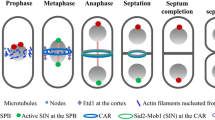Abstract
The cell cycle has undergone major advances in the last four years. A better understanding of how cells divide has been possible thanks to the fusion of two independent areas of research, one exploiting fungal genetics and molecular biology in Schizosaccharomyces pombe, Saccharomyces cerevisiae and Aspergillus nidulans, and the second based on biochemistry in Xenopus and mammalian cell lines. Here we review how the genes involved in the control of the cell cycle in fission yeast were discovered and how their gene products interact with each other.
Access this chapter
Tax calculation will be finalised at checkout
Purchases are for personal use only
Similar content being viewed by others
References
Arion, D, Meijer, L, Brizuela, L, Beach, D (1988) cdc2 is a component of the M phase-specific histone H1 kinase: evidence for identity with MPF. Cell 55: 371–378.
Booher, RN, Alfa, CE, Hyams, JS, Beach, DH (1989) The fission yeast cdc2/cdcl3/ suc 1 protein kinase: regulation of catalytic activity and nuclear localization. Cell 58: 485–497.
Draetta, G (1990) Cell cycle control in eukaryotes: molecular mechanisms of cdc2 activation. Trends Biochem Sci 15: 378–383.
Draetta, G, Beach, D (1988) Activation of cdc2 protein kinase during mitosis in human cells: cell cycle-dependent phosphorylation and subunit rearrangement. Cell 54: 17–26.
Dunphy, WG, Brizuela, L, Beach, D, Newport, J (1988) The Xenopus homolog of cdc2 is a component of MPF, a cytoplasmic regulator of mitosis. Cell 54: 423–431.
Dunphy, WG, Kumagai A (1991) The cdc25 protein contains an intrinsic phosphatase activity. Cell: 189-196.
Enoch, T, Nurse, P (1991) Coupling M phase and S phase: Controls maintaining the dependence of mitosis on chromosome replication. Cell 65: 921–923.
Gautier, J, Norbury, C, Lohka, M, Nurse, P, Maller, J (1988) Purified maturation-promoting factor contains the product of a Xenopus homolog of the fission yeast cell cycle control gene cdc2+. Cell 54: 433–439.
Gautier, J, Solomon, MJ, Booher, RN, Bazan, JF, Kirschner, MW (1991) cdc25 is a specific tyrisine phosphatase that directly activates p34cdc2. Cell 67:197–211.
Gould, KL, Moreno, S, Owen, DJ, Sazer, S, Nurse, P (1991) Phosphorylation at Thr 167 is required for Schizosaccharomyces pombe p34cdc2 function. EMBO J. 10: 3297–3309.
Gould, KL, Nurse, P (1989) Tyrosine phosphorylation of the fission yeast cdc2 protein kinase regulates entry into mitosis. Nature 342: 39–45.
Labbe, JC, Lee, MG, Nurse, P, Picard, A, Doree, M (1988) Activation at M-phase of a protein kinase encoded by a starfish homologue of the cell cycle control gene cdc2+. Nature 335: 251–254.
Lundgren, K, Walworth, N, Booher, R, Dembski, M, Kirschner, M, Beach, D (1991) mik1 and wee 1 cooperate in the inhibitory tyrosine phosphoiylation of cdc2. Cell 64: 1111–1122.
Moreno, S, Hayles, J, Nurse, P (1989) Regulation of p34cdc2 protein kinase during mitosis. Cell 58: 361–372.
Moreno, S, Nurse, P (1990) Substrates for p34cdc2: in vivo veritas? Cell 61: 549–551.
Moreno, S, Nurse, P (1991) Clues to action of cdc25 protein. Nature 351: 194.
Nurse, P, Bissett, Y (1981) Gene required in Gl for commitment to cell cycle and in G2 for control of mitosis in fission yeast. Nature 292: 558–560.
Russell, P, Nurse, P (1987) Negative regulation of mitosis by wee1+ a gene encoding a protein kinase homolog. Cell 49: 559–567.
Strausfeld, U, Labbé, J-C, Fesquet, D, Cavadore, JC, Picard, A, Sadhu, K, Russell, P, Dorée, M (1991) Dephosphorylation and activation of a p34cdc2/cyclin B complex in vitro by human CDC25 protein. Nature 351: 242–245.
Author information
Authors and Affiliations
Editor information
Editors and Affiliations
Rights and permissions
Copyright information
© 1993 Springer-Verlag Berlin Heidelberg
About this paper
Cite this paper
Moreno, S., Nurse, P. (1993). Cell cycle regulation in fission yeast. In: Maresca, B., Kobayashi, G.S., Yamaguchi, H. (eds) Molecular Biology and its Application to Medical Mycology. NATO ASI Series, vol 69. Springer, Berlin, Heidelberg. https://doi.org/10.1007/978-3-642-84625-0_1
Download citation
DOI: https://doi.org/10.1007/978-3-642-84625-0_1
Publisher Name: Springer, Berlin, Heidelberg
Print ISBN: 978-3-642-84627-4
Online ISBN: 978-3-642-84625-0
eBook Packages: Springer Book Archive




